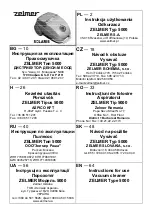
GB
28
/ 43
Mop attachment
Let any excessive water (solution) drain away from the mop attachment,
e.g. to a washbasin. Rinse the attachment
F
under running water. The mop pads
(
F1
,
F2
,
F3
) can be washed in a washing machine at 60 °C and dried in a tumble dryer.
Dust container
Use a wet cloth to clean the surface of the container B. Rinse the inside of the container
B
with water. Rinse the separator
B2
under running water. Allow all the parts to dry out
properly before their re-use.
HEPA filter
Shake out the input HEPA filter
B1
gently, or blow it out. If the HEPA filter is very dirty, you
can rinse it under running lukewarm water. Allow it to dry out properly.
Caution
–
If you clean the HEPA filter with water, its filtration properties will deteriorate.
The filter cannot be washed more than three times. After that, a new filter needs to be
purchased.
– We recommend that you replace the HEPA filter twice a year.
– The HEPA filter is not suitable for washing in the dishwasher.
– Failure to clean or replace the HEPA filter as required may cause a defect of the
vacuum cleaner!
VII. ENVIRONMENTAL PROTECTION
If the dimensions allow, there are labels of materials used for production of packing,
components and accessories as well as their recycling on all parts. The symbols specified
on the product or in the accompanying documentation mean that the used electrical or
electronic products must not be disposed of together with municipal waste. For proper
disposal of the product, hand it over at special collection places where it will be received free
of charge. Suitable disposal of the product can help to maintain valuable natural resources
and to prevent possible negative impacts on the environment and human health, which
could be the possible consequences of improper waste disposal. Fines can be imposed
for improper disposal of this type of waste in agreement with the national regulations.
The appliance is equipped with the Li-Ion/NiMH battery with long life. For environmental
protection it is necessary to remove the battery from the appliance after its service life and
the battery and the appliance must be disposed of safely using special collection networks.
Ask for more details at the local authority or at the local waste collection site.
Removing the accumulator
You can remove the accumulators from the appliance only after they have been completely
discharged (i.e. let the vacuum cleaner run until its motor stops). Unscrew the screws
and open the vacuum cleaner. Gradually cut off the supply conductors and remove the
accumulators (Fig. 6).
Содержание 5449 90000
Страница 2: ...1 A A1 A2 A3 1 1 2 3 4 5 B B1 B2 C1 C2 C D D1 D2 D3 D4 D5 1 2 4 3 E E1 E2 E3 F F4 H E4 F1 F2 F3 ...
Страница 3: ...G1 G2 G3 G4 G5 G6 2 I II 1 2 3 4 5 1 2 3 E2 E3 ...
Страница 4: ...A B C D E F H G 7 1 6 I II 2 3 4 5 6 7 III ...
Страница 5: ... A B C D E A B C1 A B C H E F A C2 E F G ETA0449 C1 C2 E ETA1449 C1 C2 E ETA5449 C1 C2 E F ...
Страница 48: ...e č 20 2017 DATE 19 6 2017 ...
















































